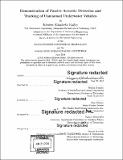| dc.contributor.advisor | Henrik Schmidt and Dino Dibiaso. | en_US |
| dc.contributor.author | Railey, Kristen Elizabeth | en_US |
| dc.contributor.other | Woods Hole Oceanographic Institution. | en_US |
| dc.date.accessioned | 2018-11-15T16:36:30Z | |
| dc.date.available | 2018-11-15T16:36:30Z | |
| dc.date.copyright | 2018 | en_US |
| dc.date.issued | 2018 | en_US |
| dc.identifier.uri | http://hdl.handle.net/1721.1/119099 | |
| dc.description | Thesis: S.M., Joint Program in Oceanography/Applied Ocean Science and Engineering (Massachusetts Institute of Technology, Department of Mechanical Engineering; and the Woods Hole Oceanographic Institution), 2018. | en_US |
| dc.description | Cataloged from PDF version of thesis. | en_US |
| dc.description | Includes bibliographical references (pages 93-99). | en_US |
| dc.description.abstract | In terms of national security, the advancement of unmanned underwater vehicle (UUV) technology has transformed UUVs from tools for intelligence, surveillance, and reconnaissance and mine countermeasures to autonomous platforms that can perform complex tasks like tracking submarines, jamming, and smart mining. Today, they play a major role in asymmetric warfare, as UUVs have attributes that are desirable for less-established navies. They are covert, easy to deploy, low-cost, and low-risk to personnel. The concern of protecting against UUVs of malicious intent is that existing defense systems fall short in detecting, tracking, and preventing the vehicles from causing harm. Addressing this gap in technology, this thesis is the first to demonstrate passively detecting and tracking UUVs in realistic environments strictly from the vehicle's self-generated noise. This work contributes the first power spectral density estimate of an underway micro-UUV, field experiments in a pond and river detecting a UUV with energy thresholding and spectral filters, and field experiments in a pond and river tracking a UUV using conventional and adaptive beamforming. The spectral filters resulted in a probability of detection of 96 % and false alarms of 18 % at a distance of 100 m, with boat traffic in a river environment. Tracking the vehicle with adaptive beamforming resulted in a 6.2 ± 5.7° absolute difference in bearing. The principal achievement of this work is to quantify how well a UUV can be covertly tracked with knowledge of its spectral features. This work can be implemented into existing passive acoustic surveillance systems and be applied to larger classes of UUVs, which potentially have louder identifying acoustic signatures. | en_US |
| dc.description.statementofresponsibility | by Kristen Elizabeth Railey. | en_US |
| dc.format.extent | 99 pages | en_US |
| dc.language.iso | eng | en_US |
| dc.publisher | Massachusetts Institute of Technology | en_US |
| dc.rights | MIT theses are protected by copyright. They may be viewed, downloaded, or printed from this source but further reproduction or distribution in any format is prohibited without written permission. | en_US |
| dc.rights.uri | http://dspace.mit.edu/handle/1721.1/7582 | en_US |
| dc.subject | Joint Program in Oceanography/Applied Ocean Science and Engineering. | en_US |
| dc.subject | Mechanical Engineering. | en_US |
| dc.subject | Woods Hole Oceanographic Institution. | en_US |
| dc.subject.lcsh | Ocean engineering | en_US |
| dc.subject.lcsh | Autonomous robots | en_US |
| dc.subject.lcsh | Autonomous vehicles Ocean engineering | en_US |
| dc.subject.lcsh | Marine engineering | en_US |
| dc.title | Demonstration of passive acoustic detection and tracking of unmanned underwater vehicles | en_US |
| dc.type | Thesis | en_US |
| dc.description.degree | S.M. | en_US |
| dc.contributor.department | Joint Program in Oceanography/Applied Ocean Science and Engineering | en_US |
| dc.contributor.department | Woods Hole Oceanographic Institution | en_US |
| dc.contributor.department | Massachusetts Institute of Technology. Department of Mechanical Engineering | |
| dc.identifier.oclc | 1059464132 | en_US |
